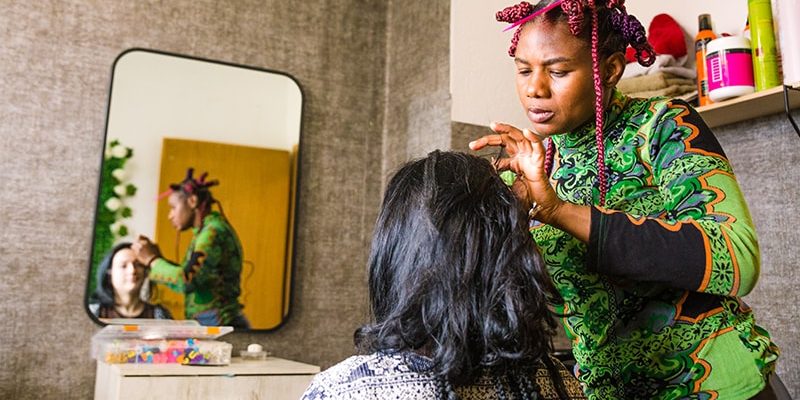Women talk about a lot of things at the beauty salon and sometimes that includes conversations about their sexual health.
Sometimes the banter is initiated by a client getting their hair done, but what would happen if the medical community could train the hair stylist in an at-risk community to start that conversation and ease stigma about sexual health?
In a pilot program run by the HEEAT Research Lab, investigators recruited two hair stylists and salon owners to join forces as part of their research team.
They built a workforce of 19 stylists and headed into the community to interact with women about how to prevent HIV.
Black women make up more than half — 64% — of all new HIV diagnoses among women even though they account for only 13% of the population in the US, explained principal investigator Schenita D. Randolph, PhD, MPH, RN, associate professor at Duke University School of Nursing, Durham, North Carolina.
HIV prevalence is highest in the South — accounting for more than half of all US HIV infections — where the majority of Black Americans live.
Yet the vast majority of people taking medication to avoid HIV infection are men. About 90% of pre-exposure prophylaxis users are male with just 21% Black, Randolph said, citing a study from 2022.
PREP uptake among Black women represents a national priority in ending the HIV epidemic by 2030, she said while presenting the new approach at the Association of Nurses in AIDS Care (ANAC) 2023 Annual Meeting in New Orleans, Louisiana.
“Building community partnerships with trusted venues and gatekeepers, such as beauty salon stylists, is one strategy to overcome the barriers to PREP uptake, including stigma, trust, and access,” said Randolph.
Black Women at Risk
The researchers developed a nurse-led, community-based intervention aimed at increasing women’s knowledge and uptake of PREP while dispelling stigma. The approach consists of three parts: educating stylists of Black women to be opinion leaders, sharing entertaining educational videos, and linking people to a PREP navigator who could help with HIV testing, counseling, and referral to a PREP locator.
The program was designed to be culturally relevant, sustainable, and accessible for real-world delivery to social networks, said Randolph.
Stylist training lasted 2 hours and provided continuing education credits. Key aspects of the two-part training included addressing HIV myths and misconceptions, providing basic information on HIV and PREP, and risk reduction.
“It was easy, straightforward information,” one stylist said in feedback about the training that was broken down in easy-to-understand terms.
The HEEAT lab produced videos for customers at the salons that they accessed using a QR code. Some of the women felt very comfortable having conversations in the salon openly, Randolph said, but women who did not feel as comfortable could view the videos privately.
Among the 105 participants recruited to participate in the project, 44 had pretest and post-test scores to analyze. The women were an average of 42 years old, and most had a bachelor’s degree or some college. Analysis of the surveys showed that the project increased participants’ knowledge and awareness around PREP and lowered interpersonal stigma about its use.
“We wanted Black women to see themselves in their everyday life,” Randolph explained. “We also wanted women of different backgrounds to see themselves and their lives and some of the social determinants of health, such as access to health insurance, family history, and transportation.”
Dalmacio Dennis Flores, PhD, an assistant professor of nursing at the University of Pennsylvania, Philadelphia, who moderated the session with Randolph’s presentation, said the expansion of health promotion agents to include hairstylists was “genius.”
Culturally Relevant
“We all have a constellation of influencers in our lives and utilizing novel ones for PREP uptake is commendable,” Dennis Flores told Medscape. “We’ve heard of health interventions in barbershops before,” he added, and “expanding it to hair salons makes it germane for women at risk for HIV.”
Dennis Flores said this study is a reminder that “everyone in HIV prevention can do better to reach subpopulations who don’t hear about all the options they have at their disposal.”
These types of culturally relevant nurse-led interventions that collaborate with trusted community partners have the potential to improve awareness and uptake among Black women, Randolph said, and they are generalizable to other beauty salons throughout the Southern US.
Rasheeta D. Chandler, PhD, RN, an associate professor at Emory University’s Nell Hodgson Woodruff School of Nursing in Atlanta, Georgia, was not involved in the research and was “excited to see a resurrection in the use of community-specific venues that are a staple for Black women,” she told Medscape.
Black women often see their stylist or beautician as a confidant, she said. “There’s a level of trust that has to be there for you to let people into that level of personal space of yours, especially if you’ve been going to that person for a number of years,” Chandler said. “So I think it’s a great approach to the topic and demystifying it and allowing women to be able to talk about their sexuality in a way that is not judgmental or stigmatizing.”
Chandler says she was also impressed with the scalability of the intervention. “There’s just some elements of Black culture that translate across every region, and the salon is one of those settings that has a similar vibe whether it’s in New York or Georgia or North Carolina,” she said. “You’re going to have that relationship in the same way no matter what region you are in.”
Randolph said the HEEAT Lab is finalizing a toolkit that includes videos that clinicians, community-based organizations, and stylists and beauty salons can use for their own interventions, and they are continuing to offer the free training to stylists. They are also developing a randomized control trial to test the intervention in other salons.
Source: Read Full Article
